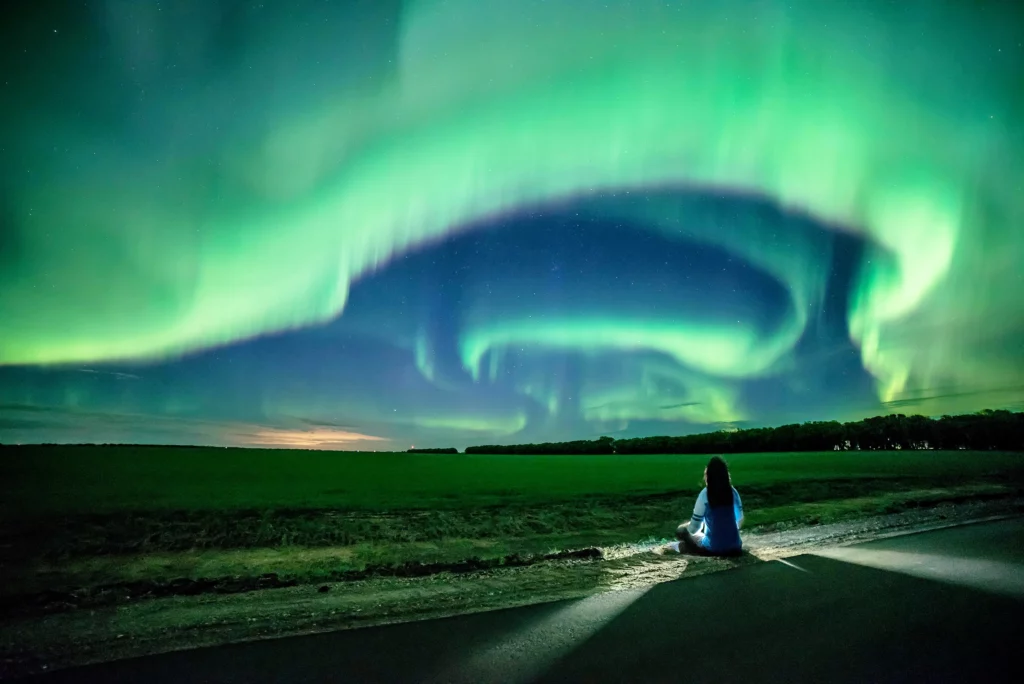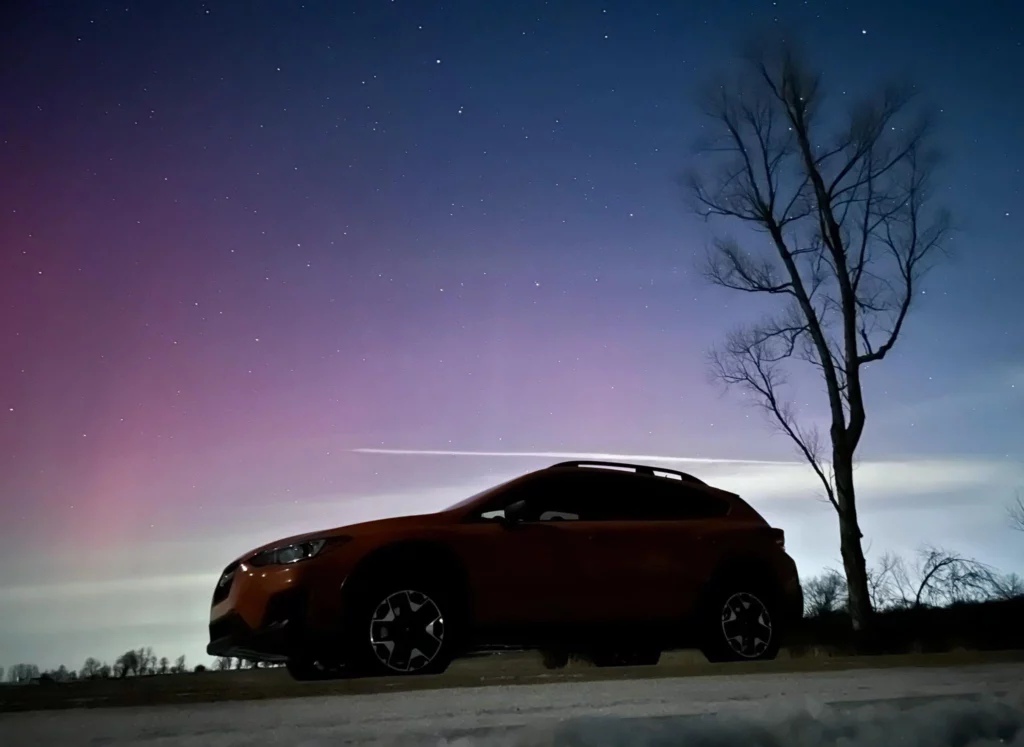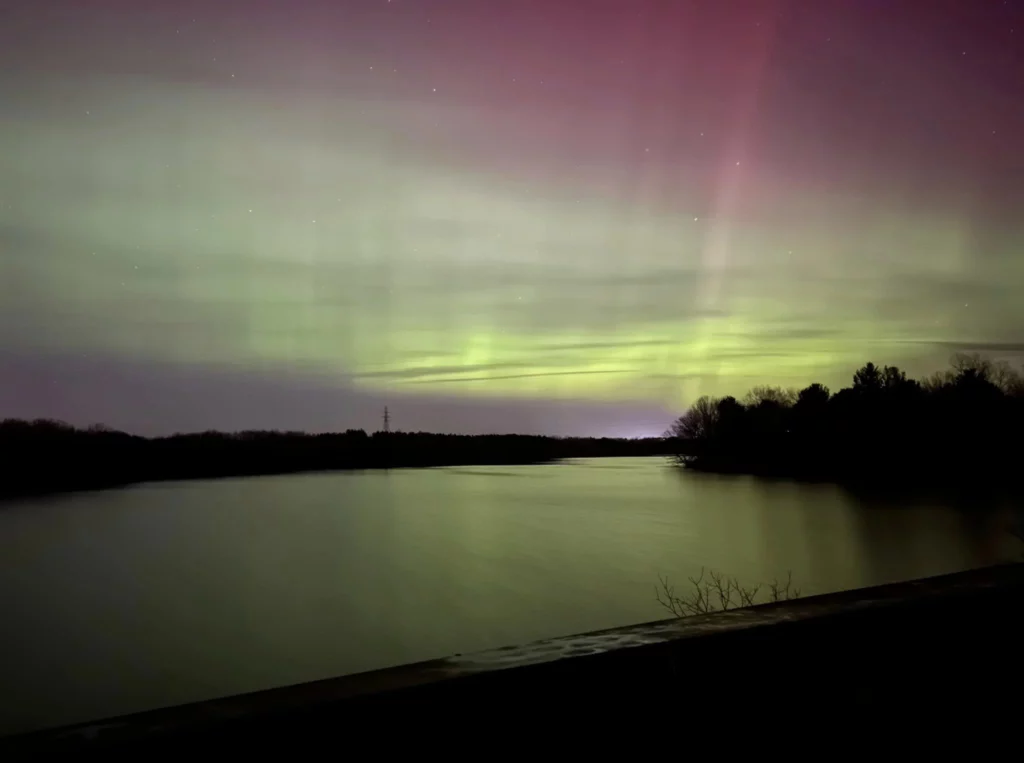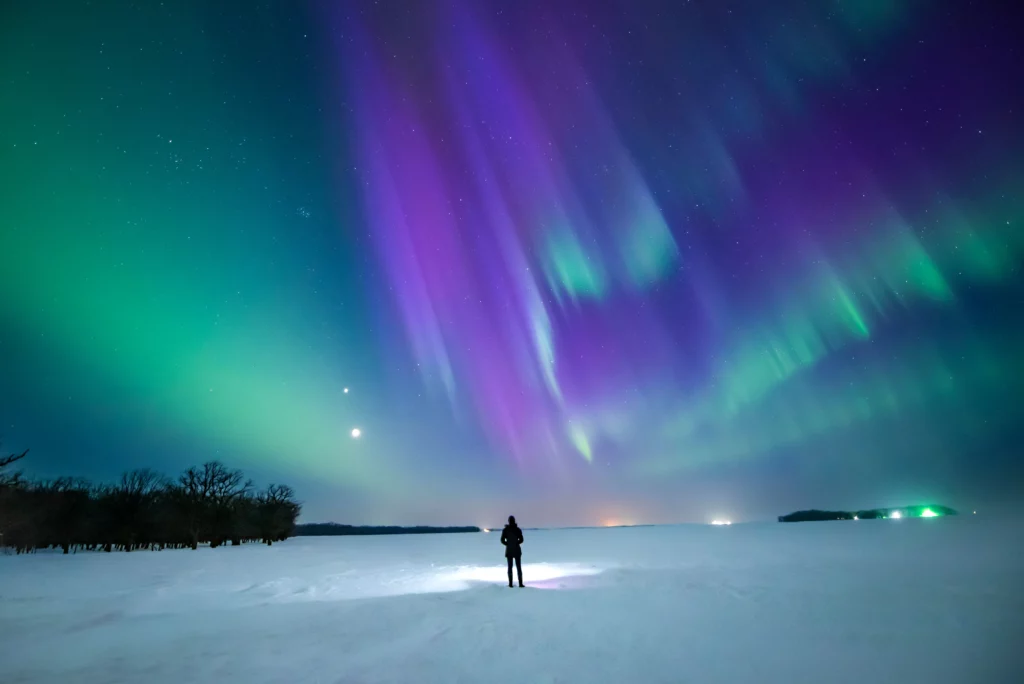
Aurora chasers across the Midwest work together to capture the beauty of the northern lights.
Lights danced from sunset to dawn, taking on new shapes and formations for hours on end. A pastel watercolor took form as brushstrokes of purples, greens, and pinks painted the sky. It was hypnotizing. Mesmerizing. Nearly impossible to look away. And exactly what Melissa F. Kaelin had hoped for.
It was March of 2021. Kaelin had gone on an aurora chase with a group of friends in the upper peninsula of Michigan. The Northern Lights are just about as reliable as your flaky friend, but it was the spring equinox, meaning there would be 12 hours of darkness. And there were signs a strong geomagnetic storm was going to take place, meaning there could be an aurora display. The lights were on their side that night.
The group bundled up on a beach on Lake Superior and watched the lights for hours. At 2 a.m., Kaelin hopped into her orange Subaru and drove back to her hotel to check on her dog. When she stepped onto her balcony, the aurora had only gotten stronger.
“This really vivid neon green ball of light started rolling across the lake,” she says. “It felt like the Northern Lights were coming straight toward me.”

Yes, the Northern Lights can be seen in the Midwest.
It’s not necessary to travel to the North Pole to see the Northern Lights. Aurora sightings actually occur all over the Midwest, and there are communities that work together to capture the beautiful light shows.
Despite that, chasing auroras in the mid-latitudes of the Midwest is not easy. The Northern Lights enter the Earth’s atmosphere from the North and South Poles. That’s why it is difficult to spot auroras at the 45th parallel, which is the latitude line that’s halfway between the equator and the North Pole. Aurora sightings are more common above the 45th parallel, particularly during winter when it tilts further from the sun. Therefore, North Dakota, most of Minnesota, northern Wisconsin, northern Michigan, and even the northern parts of South Dakota tend to have aurora sightings more often. However, it’s not impossible to see the Northern Lights below the 45th parallel. There are just more factors that go into making the conditions right for an aurora.
If a chaser wants to track down the Northern Lights, they first should monitor solar activity. The sun is to thank for the night sky spectacle. Massive bursts of energy from the sun known as solar storms shoot out energized particles, a.k.a. solar wind, toward the planet. Those particles collide with the Earth’s magnetic field in the upper atmosphere, anywhere between 80 and potentially a 1000 miles above the surface, creating the flashing lights of an aurora.
So how does somebody monitor solar activity? The 3-day forecast from the National Oceanic and Atmospheric Administration can help with that. This resource provides data regarding geomagnetic activity, which helps predict whether a strong geomagnetic storm will occur. These storms are what pushes an aurora southward and into the Midwest. The 3-day forecast tells chasers the level of geomagnetic storms from a scale of G1 to G5, with G1 being minor and G5 being extreme. The stronger the storm, the farther south the aurora will be pushed.
Kaelin didn’t know any of this when she first became fascinated with auroras. In fact, the author, painter, and photographer was 27-years-old when she first found out that the Northern Lights could even be seen in the Midwest. Before moving to Michigan in 2018, Kaelin lived in Minnesota for 11 years. During her time there, Kaelin discovered photos of the Northern Lights on the front page of her newspaper. She was instantly entranced and wondered where the photos were taken. Then came the bombshell: The photos were taken within miles of her house.
“When I realized that they basically happened in my backyard while I was sleeping, I was fascinated and decided [that I had] to learn everything I can and see these for myself,” Kaelin says.
That was back in 2012. She didn’t have a science background starting out, so she read articles about how auroras are created, studied data from the Space Weather Prediction Center, and connected with countless different social media groups filled with curious people fascinated by the Northern Lights like her. In 2013, Kaelin became an admin for the Great Lakes Aurora Hunters Facebook group.
Creating a welcoming community
When Kaelin moved to Michigan, she discovered there were no large aurora chasing groups that welcomed aurora sightings across the entire state. She figured the barrier may have been that some residents didn’t realize the Northern Lights could be spotted in the far south of the state. So, she started her own group.
In 2021, Kaelin created the Michigan Aurora Chasers Facebook group. She also began posting aurora chasing advice on her social media, which eventually turned into a blog that lives on her website, KaelinArt.com. The popularity of her blog and the growing community of Michigan Aurora Chasers inspired her to publish her beginner’s guidebook Below the 45th Parallel.
Because catching auroras involves a lot of data analysis, Kaelin’s community helps notify chasers when there is aurora activity. Kaelin and other members post updates on their Facebook group about predictions of strong geomagnetic storms and potential aurora sightings. But her work doesn’t just help chasers in Michigan—it helps people all over the Midwest track down the elusive night sky spectacle.

“The more people involved, the better,” Minnesotan photographer Megan Sugden says. “And it’s easier to find or to go out and capture it if you know that it’s happening. So I find the real-time, real people reporting is better than any app.”
Sugden first met Kaelin in 2016 after her photos of a Northern Lights show got posted on CBS News’s website. Kaelin reached out to her to interview her for an article, and the two chasers met later that year in Duluth during an aurora chasing conference. Kaelin also met chaser and travel guide Dixie Burbank at the conference. When the original group that hosted the conference decided not to continue the event, Kaelin and Burbank decided to start the Aurora Summit together.
The first Aurora Summit happened in 2017 on Lake Superior’s shore in Minnesota. The international conference is for aurora chasers of all backgrounds and experience levels. A group of experts leads the weekend-long event and participants can enjoy presentations on a variety of topics, including aurora photography, astronomy and space weather, and mythology.
“[I hope the conference provides] networking opportunities and learning from other like-minded people,” Burbank says. “Every year we see expansion in the aurora and space weather science areas and effectively help our attendees recognize activity and potentially capture images.”
While Kaelin, Sugden, and Burbank all live in different states, the chasers keep in touch through the online chase community.
“I find that she’s the most knowledgeable and reliable of all of the people I’ve known online,” Sugden says. “I mostly check on her page to see, is it worth looking out tonight? She’s a great resource for that.”
There’s no need to be afraid of the dark.
Tracking down the Northern Lights is difficult, but that’s just one of many hurdles to jump through. From finding a good viewing location to working in extremely cold weather, chasers have to be flexible to overcome challenges.
“You could go out chasing an aurora for all the conditions to just sort of fall through and the forecast doesn’t pan out and you miss it completely,” Kaelin says. “So aurora chasers have to be a really kind of patient type of person, but they also have to be adventurous enough to go out in the dark in the middle of the night.”

It can be daunting to venture out into the night, and it’s important to take safety precautions when aurora chasing. Threatening animals and treacherous hills could cross a chaser’s path, and unreliable cell service makes it difficult to get help in an emergency situation.
That’s why it’s important to let others know where you are going and when. Packing a first aid kit also doesn’t hurt. The Midwest aurora chasing community is also a great resource for members to lean on.
“Often these strangers are running into each other in the middle of the night,” Kaelin says. “Two photographers with their tripods set up and their cameras on top, standing almost side by side in the darkness and they’ll strike up a conversation…You might end up getting advice from someone in the dark who you’ve never met, and watching a show together.”

Madeline, this is such a great story, and beautifully written by you. I didn’t know any of this! 🙂